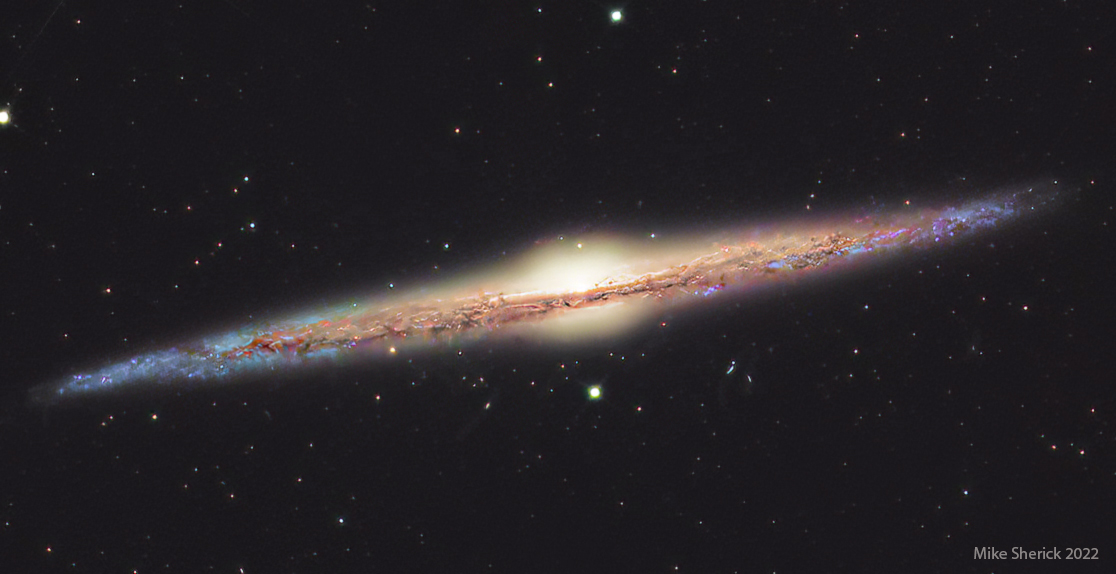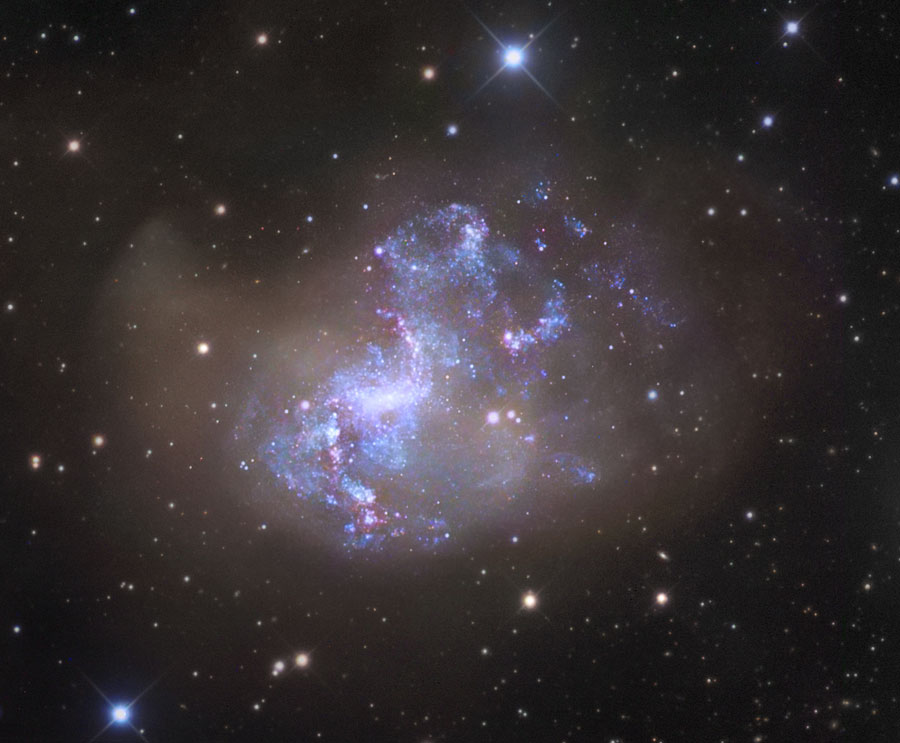MarkBour wrote: ↑Thu May 26, 2022 3:45 pm
Ann wrote: ↑Thu May 26, 2022 5:19 am
Let me begin by passing a verdict: NGC 4565 is a quite yellow galaxy
███, and not very colorful at all.
. . .
So there are blue stars in NGC 4565, but they are not very bright, and they are not found in large clusters. And there are no large bright pink emission nebulas, even though there are undoubtedly small faint emission nebulas there.
. . .
Ann
Thanks for the info!
If a galaxy is yellow and relatively quiet, do you conclude that it's older than the more active star-forming galaxies, or is it just that it has less gas, or maybe it has plenty of gas, but less of it is "in the mood" for star formation?
I don't think we should describe galaxies as "older" or "younger", because I think that almost all at least moderately large galaxies are very old. That is to say that their oldest member stars are probably as old as the globular clusters, 10-12 billion years old, or even older.
Wikipedia wrote:
I Zwicky 18 is a blue compact dwarf galaxy located about 59 million light years away in the constellation Ursa Major...
Studies at the Palomar Observatory some 40 years ago led astronomers to believe that the galaxy erupted with star formation billions of years after its galactic neighbours. Galaxies resembling I Zwicky 18's youthful appearance are typically found only in the early universe.
Early observations with the Hubble Space Telescope suggested an age of 500 million years old for I Zwicky 18...
Later observations with the Hubble Space Telescope found faint and old stars contained within the galaxy,
suggesting its star formation started at least one billion years ago and possibly as much as ten billion years ago. The galaxy, therefore, may have formed at the same time as most other galaxies.
So I don't think that galaxies are young. They are all old. The only exceptions that I can think of are the dwarf galaxies that condense out of the wreckage of tidal tails thrown out by larger galaxies in the throes of ongoing mergers or collisions:
The large blue clusters in the tidal tail of the Tadpole Galaxy
will evolve into future dwarf galaxies.
But with the exception of newly formed tidal wreckage dwarf galaxies, galaxies are not young, but old. The question is whether they are still forming stars, and if they are, how vigorously they are doing so.
Sometimes it is very hard to understand why galaxies suddenly start forming a tremendous amount of stars.
Consider starburst galaxy NGC 1313.
APOD Robot wrote:
Why is this galaxy so discombobulated? Usually, galaxies this topsy-turvy result from a recent collision with a neighboring galaxy.
Spiral galaxy NGC 1313, however, appears to be alone. Brightly lit with new and blue massive stars, star formation appears so rampant in NGC 1313 that it has been labeled a starburst galaxy.
Weird, eh? This galaxy is all alone, and yet it is absolutely tormented and bent all out of shape because of its tremendous star formation. Perhaps it has collided with a clump of dark matter?
Maybe. But I think it is equally likely that NGC 1313 has discombobulated itself all by itself, by having its enhanced star formation at both ends of the bar suddenly turn into an almost "runaway" starburst, again at both ends of the bar. And because of the galaxy's obvious low mass, the tremendous forces of this "simultaneous double-sided" starburst may have severely unbalanced the galaxy and led to its contorted shape.
But other galaxies that sit quietly all alone do indeed form stars slowly. That is the case for the "UFO galaxy", NGC 2683:
Wikipedia wrote:
NGC 2683 is a field spiral galaxy in the northern constellation of Lynx. It was nicknamed the "UFO Galaxy" by the Astronaut Memorial Planetarium and Observatory...
It is also both smaller and less luminous than the Milky Way with very little neutral hydrogen or molecular hydrogen and a low luminosity in the infrared, which suggests a currently low rate of star formation.
NGC 2683 is rich in globular clusters, hosting about 300 of them, twice the number found in the Milky Way.
NGC 2683 appears to be located in a cosmic void, where there are few galaxies:
Michael König and Stefan Binnewies wrote in The Cambridge Photographic Atlas of Galaxies:
The SA(rs)B galaxy NGC 2683 is about 6o east of the star Alpha Lyncis. It is part of the sparse environment of the Lynx-Cancer Void, a nearby filament of about 100 galaxies, many of them dwarfs.
So it would appear that NGC 2683 is located in a relatively unusual and sparse environment. Its large number of globulars suggests it has undergone several mergers in the past, and its low levels of neutral and molecular hydrogen suggests it has lost or used up much of its gas during its mergers. For now, it appears to be "quiet".
The reason why I brought up NGC 2683 is that it reminds me a little of NGC 4565, which strikes me as very "quiet" indeed, more so than NGC 2683. NGC 4565 looks so undisturbed to me.
As to why NGC 4565 is forming stars slowly, I don't know. It could be because it has low levels of neutral and molecular gas. But in my opinion, it could also be because for whatever reason, it hasn't had the necessary triggers to convert its gas to stars in massive bursts of star formation.
As to why some galaxies just start bursting with star formation while others sit rather quietly, I don't know. Consider NGC 6822:
I'm all but sure that I have read that NGC 6822 sits in a large reservoir of gas, yet it isn't bursting with star formation. Yes, it is forming stars, but compared with I Zwicky 18 (which is interacting with another galaxy) or NGC 1313 (which is not), its rate of star formation is not too impressive. Don't ask me why this is so!
And that is all I have to say on the matter.
Ann
 NGC 4565: Galaxy on Edge
NGC 4565: Galaxy on Edge
















